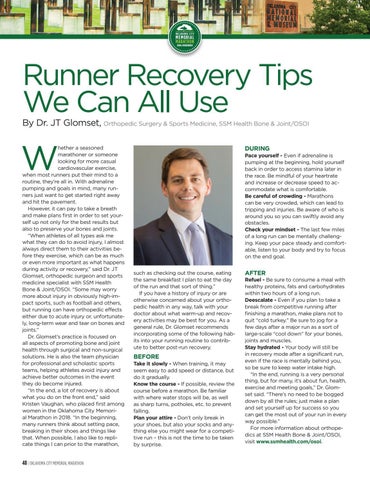Runner Recovery Tips We Can All Use By Dr. JT Glomset, Orthopedic Surgery & Sports Medicine, SSM Health Bone & Joint/OSOI
W
hether a seasoned marathoner or someone looking for more casual cardiovascular exercise, when most runners put their mind to a routine, they’re all in. With adrenaline pumping and goals in mind, many runners just want to get started right away and hit the pavement. However, it can pay to take a breath and make plans first in order to set yourself up not only for the best results but also to preserve your bones and joints. “When athletes of all types ask me what they can do to avoid injury, I almost always direct them to their activities before they exercise, which can be as much or even more important as what happens during activity or recovery,” said Dr. JT Glomset, orthopedic surgeon and sports medicine specialist with SSM Health Bone & Joint/OSOI. “Some may worry more about injury in obviously high-impact sports, such as football and others, but running can have orthopedic effects either due to acute injury or, unfortunately, long-term wear and tear on bones and joints.” Dr. Glomset’s practice is focused on all aspects of promoting bone and joint health through surgical and non-surgical solutions. He is also the team physician for professional and scholastic sports teams, helping athletes avoid injury and achieve better outcomes in the event they do become injured. “In the end, a lot of recovery is about what you do on the front end,” said Kristen Vaughan, who placed first among women in the Oklahoma City Memorial Marathon in 2018. “In the beginning, many runners think about setting pace, breaking in their shoes and things like that. When possible, I also like to replicate things l can prior to the marathon,
48 | OKLAHOMA CITY MEMORIAL MARATHON
DURING Pace yourself - Even if adrenaline is pumping at the beginning, hold yourself back in order to access stamina later in the race. Be mindful of your heartrate and increase or decrease speed to accommodate what is comfortable. Be careful of crowding - Marathons can be very crowded, which can lead to tripping and injuries. Be aware of who is around you so you can swiftly avoid any obstacles. Check your mindset - The last few miles of a long run can be mentally challenging. Keep your pace steady and comfortable, listen to your body and try to focus on the end goal. such as checking out the course, eating the same breakfast I plan to eat the day of the run and that sort of thing.” If you have a history of injury or are otherwise concerned about your orthopedic health in any way, talk with your doctor about what warm-up and recovery activities may be best for you. As a general rule, Dr. Glomset recommends incorporating some of the following habits into your running routine to contribute to better post-run recovery.
BEFORE Take it slowly - When training, it may seem easy to add speed or distance, but do it gradually. Know the course - If possible, review the course before a marathon. Be familiar with where water stops will be, as well as sharp turns, potholes, etc. to prevent falling. Plan your attire - Don’t only break in your shoes, but also your socks and anything else you might wear for a competitive run – this is not the time to be taken by surprise.
AFTER Refuel - Be sure to consume a meal with healthy proteins, fats and carbohydrates within two hours of a long run. Deescalate - Even if you plan to take a break from competitive running after finishing a marathon, make plans not to quit “cold turkey.” Be sure to jog for a few days after a major run as a sort of large-scale “cool down” for your bones, joints and muscles. Stay hydrated - Your body will still be in recovery mode after a significant run, even if the race is mentally behind you, so be sure to keep water intake high. “In the end, running is a very personal thing, but for many, it’s about fun, health, exercise and meeting goals,” Dr. Glomset said. “There’s no need to be bogged down by all the rules; just make a plan and set yourself up for success so you can get the most out of your run in every way possible.” For more information about orthopedics at SSM Health Bone & Joint/OSOI, visit www.ssmhealth.com/osoi.






